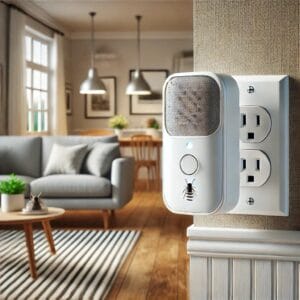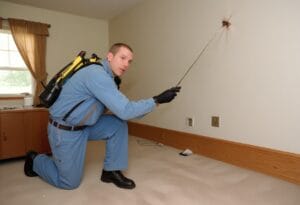Key Points: The Reality of Ultrasonic Repellents
- Ultrasonic pest repellers are not a one-size-fits-all solution for pest control.
- Scientific research on the effectiveness of ultrasonic pest repellers is not conclusive.
- The performance of ultrasonic devices can be influenced by environmental factors and the type of pests.
- Effective pest control often requires a combination of methods, not just one solution.
- It’s important to have realistic expectations and understand the limitations of ultrasonic pest repellents.
Myth Busting: The Facts About Ultrasonic Pest Repellers

When dealing with unwanted pests in your home, the idea of an easy, plug-in solution like ultrasonic pest repellers can be appealing. But before you depend on these devices as your main form of protection, let’s look at some of the myths about their effectiveness.
The One-Size-Fits-All Myth
Some manufacturers of ultrasonic repellers claim that their devices can repel just about any pest. However, pests have different hearing abilities and behaviors. What may mildly annoy one pest may not bother another pest at all. The notion that a single solution can effectively repel all pests is overly simplistic and can often lead to disappointment.
Immediate Results: A Common Misconception
Many people believe that ultrasonic repellers work right away. However, if these devices have any effect at all, it’s typically over a period of regular use, and the results may not be obvious. Pests are unlikely to run out the door the second you plug the device in. It’s important to be patient and keep an eye on the situation.
Claims of Safety and Pet Compatibility
Ultrasonic repellers are frequently advertised as being safe for humans and pets. While it’s accurate that the majority of individuals are unable to hear the high-frequency sounds produced by these gadgets, certain pets may be affected by them. If you’re worried, it’s crucial to keep an eye out for signs of discomfort in your pets and seek advice from a vet.
The “One and Done” Fallacy
Another common misconception is that ultrasonic repellers are a “one and done” solution. These devices can degrade or lose their effectiveness over time. Furthermore, pests can become accustomed to the noise, making the repellers ineffective. Regular upkeep and a comprehensive pest control strategy are typically required.
Let’s take a closer look at how these gadgets are supposed to function and why they may not be the miracle solution you’re seeking.
Understanding the Different Types of Pests and Their Reactions
It’s important to know what pests you’re dealing with because not all of them react the same to ultrasonic frequencies. For example, rodents might be somewhat bothered by ultrasonic noise at first, but bugs like cockroaches and bedbugs don’t seem to care much. This difference in reactions is important to remember because it could make you think these devices work for all pests when they really don’t.
Furthermore, the location matters. Ultrasonic waves aren’t able to go through walls or bend around corners efficiently. This implies that even if certain pests are sensitive to these frequencies, the repellers may not reach them if the pests are nesting in hard-to-reach places. Therefore, while ultrasonic repellers may provide a certain amount of deterrence against specific pests under perfect conditions, they should not be viewed as a complete solution.
Why Ultrasonic Repellers Fall Short

Ultrasonic pest repellers have a significant disadvantage because they depend on sound waves, which are easily interrupted. Everyday household objects like furniture and fabrics can absorb or deflect these sounds, greatly diminishing their range. This often leads to an overestimation of how effective these devices are, resulting in a misunderstanding of their pest control abilities.
Furthermore, ultrasonic pest repellers may lose their effectiveness over time. Pests can get used to the noise, or the device may lose power or effectiveness. Regular and frequent checks of the repeller’s performance are needed to make sure it’s still working as it should.
Word of Mouth vs. Hard Facts
Despite the numerous tales of ultrasonic repellers being miracle workers, one should always be skeptical of anecdotal evidence. The scientific community has conducted numerous studies on the effectiveness of these devices, and the results have been inconclusive. Some research indicates that they may have a temporary effect on some pests, while other studies have found them to be completely ineffective. Given the lack of consistent and reliable data, it’s hard to recommend ultrasonic repellers as a trustworthy method of pest control.
Recognizing the Limitations of Range and Frequency
Another factor to take into account is the range of ultrasonic pest repellers. Most of these devices have a limited range of effectiveness, which they may not explicitly mention. This implies that you might require several units to cover your entire house, which can result in higher expenses and potential hassle. Moreover, the frequency of the sound waves can differ between models, and not all pests respond to the same frequencies. For more insight into effective pest management strategies, you might want to explore eco-friendly pest control methods that are safe for your family and pets.
The effectiveness of ultrasonic waves can be affected by environmental factors such as temperature and humidity. If the area has thick walls or a lot of furniture, the sound might not be able to reach the pests, making the device useless.
Why Pests May Not Be Bothered By Ultrasonic Noise
It’s not just a question of whether pests can hear the ultrasonic noise; it’s also a matter of whether they see it as a danger. Pests may initially respond to ultrasonic repellers, but if the noise doesn’t pose a real threat, they’re likely to disregard it and carry on with their activities. Pests are driven by survival instincts to adapt rapidly to their surroundings, which includes ignoring sounds that aren’t threatening.
Additionally, pests are motivated by fundamental needs like food, water, and shelter. If these needs are fulfilled in an environment that also has an ultrasonic repeller, the comfort of these resources could be more appealing than the discomfort caused by the noise. This further diminishes the chance of the repeller making a lasting difference in pest behavior.
Effective Pest Management Techniques

For successful pest management, it’s crucial to use methods that have been tried and tested. While ultrasonic repellers may be part of your plan, they shouldn’t be the only tool you rely on. A combination of various techniques suited to your particular pest issue will be more effective.
Successful and Reliable Techniques for Pest Control
Reliable pest control usually requires a mixture of tactics, such as closing off entrances, keeping things clean, decreasing dampness, and using traps or lures. For more stubborn or serious invasions, chemical treatments may be needed. When used correctly, these techniques have been tried over time and have consistently produced results.
Why You Should Consider Hiring a Professional Pest Control Service
Although do-it-yourself methods can be effective, sometimes it’s best to leave it to the professionals. Pest control services have the knowledge and experience to assess your situation, identify the pests, and create a personalized plan that often involves a combination of the methods we’ve discussed. They also have access to stronger treatments and can safely apply them where necessary.
Steps to Prevent Pests from Invading Your Home
It’s always easier to prevent pests from entering your home than to get rid of them once they’ve settled in. Here are some tips to make your home less attractive to pests:
- Always keep food in sealed containers and take out the trash regularly.
- Repair any leaks and get rid of any standing water.
- Seal any cracks or crevices where pests might be able to get in.
- Keep your yard tidy and make sure to keep plants trimmed back from your house.
What to Expect from Pest Control Methods

When considering pest control, it’s crucial to have a realistic outlook. There’s no guaranteed solution, and pests can still invade despite your best attempts. Knowing what each control method, such as ultrasonic repellers, can and cannot do will help you make educated choices and strategize your pest management efforts.
Summing up, ultrasonic pest repellers can be a component of a more comprehensive pest control plan, but they’re not a cure-all. It’s important to use them in conjunction with other techniques and to stay on top of pest control habits in your home. This way, you’ll have a far better shot at keeping those unwelcome guests out.
Examining the Effectiveness and Efficiency
When looking at ultrasonic repellers, it’s important to critically examine their effectiveness and efficiency. Are they working, and are they working well? To begin with, effectiveness can be inconsistent, depending on the pest type and the environment. Efficiency, meanwhile, is about cost-effectiveness and practicality. If you need multiple units to cover your home, the costs can accumulate, and having too many devices could become impractical.
Important Things to Consider Before Choosing a Pest Control Method
Before you decide on ultrasonic repellers or any other pest control method, take the following into account:
- Identify the type of pest you are dealing with to make sure you are using the right methods.
- Think about the size and layout of your area; some methods work better in different environments.
- Take into account any possible risks to pets or children.
- Think about the long term; look for solutions that will last instead of quick fixes.
- Don’t forget about preventative measures to keep pests from returning.
Commonly Asked Questions
Are ultrasonic repellers dangerous for my pets or children?

Ultrasonic repellers are generally designed to produce sounds at frequencies that are beyond the hearing range of humans and most pets. However, some animals, especially rodents and other pets like rabbits or guinea pigs, might be able to hear these frequencies. Watch your pets for signs of discomfort, and if you’re unsure, check with a vet. For more information on keeping your pets safe, refer to our guide on eco-friendly pest control methods.
How frequently should I change out ultrasonic pest repellers?
Ultrasonic pest repellers are not made to last forever. They can become less effective over time, so it’s a good idea to switch them out every couple of years or as suggested by the maker. Also, watch out for signs of performance; if you see that pests are not being repelled anymore, it may be time to get a new one.
Will ultrasonic repellers cause pests to leave my neighbor’s home and come to mine?
It’s not very likely that ultrasonic repellers will cause pests to leave your neighbor’s home and come to yours. Pests are more likely to be influenced by the availability of food, water, and shelter than by the deterrent devices. However, if your neighbors are using repellents and you aren’t, your home could become more attractive to pests that have been displaced.
Are ultrasonic devices actually effective at repelling any pests?
Although there is some research that indicates that pests such as rodents may be briefly deterred by ultrasonic devices, there is no solid proof that any pest is consistently repelled by these devices. It’s crucial to incorporate these devices into a more comprehensive integrated pest management approach.
What can I do right now to keep pests away without using ultrasonic devices?
If you want to take action right away to keep pests away, you can:
- Keep your home clean and free of food crumbs.
- Seal any cracks or gaps in walls, windows, and doors to stop pests from getting in.
- Use traditional traps and baits for immediate, targeted pest control.
- Keep your garden and yard maintained to minimize pest breeding areas.
- Get a professional pest control service to do a complete inspection and treatment.
Your content is empty. Please provide the content you’d like me to rewrite.





